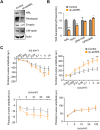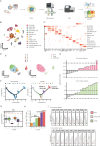In vivo efficacy of NRL knockdown with cell-penetrating siRNA in retinal degeneration
- PMID: 40715177
- PMCID: PMC12297344
- DOI: 10.1038/s41598-025-07299-6
In vivo efficacy of NRL knockdown with cell-penetrating siRNA in retinal degeneration
Abstract
Retinal degenerative diseases, such as retinitis pigmentosa (RP) and age‑related macular degeneration (AMD), lead to progressive vision loss through photoreceptor degeneration; RP begins with the gradual loss of peripheral rods, whereas AMD causes central‑vision loss mainly because macular cones and parafoveal rods degenerate. The neural retina leucine zipper (NRL) directs rod photoreceptor differentiation, and its disruption has been linked to upregulated cone-specific markers in rods. This study investigates the therapeutic potential of a cell-penetrating asymmetric small interfering RNA targeting NRL (cp-asiNRL) to induce rod-to-cone conversion and mitigate retinal degeneration. cp-asiNRL was administered intravitreally to C57BL/6J wild-type (WT), neovascular AMD (nAMD), and RP (RhoP23H/+) mouse models. Subsequent analyses included cone marker expression levels and electroretinographic evaluations, and single-cell RNA sequencing. Administration of cp-asiNRL suppressed NRL expression, increased cone marker expression, and improved retinal function in both WT and nAMD models. In RP mice, cone marker expression was also elevated, although functional improvements were comparatively modest, likely reflecting the advanced disease stage. Single-cell RNA sequencing revealed a rod-to-cone-like transdifferentiation, suggesting that cp-asiNRL-mediated NRL knockdown partially preserved photoreceptor integrity. cp-asiNRL-mediated NRL silencing shows considerable promise as a therapeutic intervention for retinal degenerative conditions. By promoting rod-to-cone transdifferentiation and supporting photoreceptor survival, this approach may offer a novel strategy for vision preservation.
© 2025. The Author(s).
Conflict of interest statement
Competing interests: H.J., T.H., M.Y., S.P., S.W.H., and D.K.L. are employees of OliX Pharmaceuticals Inc. H.C. serves as a consultant for OliX Pharmaceuticals Inc. A related patent application has been filed: PCT/KR2021/018460. The remaining authors - H.L., J.C., H.K.L., C.S., C.P., S.Y.L., J.L., and S.L. - declare no competing interests.
Figures





References
-
- Li, J. Q. et al. Prevalence and incidence of age-related macular degeneration in Europe: a systematic review and meta-analysis. Br. J. Ophthalmol.104, 1077–1084 (2020). - PubMed
-
- Teo, C. L. et al. Prevalence of retinitis pigmentosa in singapore: the Singapore Epidemiology of Eye Diseases Study. Acta Ophthalmol.99, e134–e135. 10.1111/aos.14483 (2021). - PubMed
MeSH terms
Substances
Grants and funding
LinkOut - more resources
Full Text Sources
Miscellaneous

